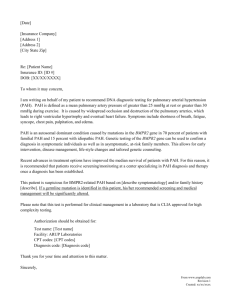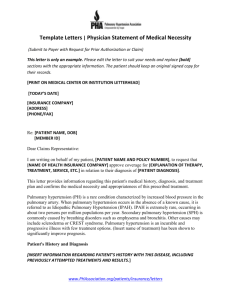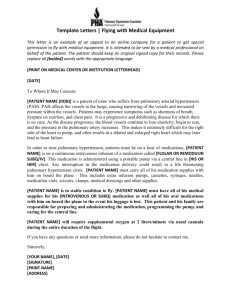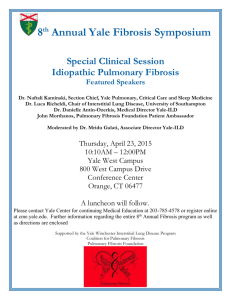metabolism lung
advertisement
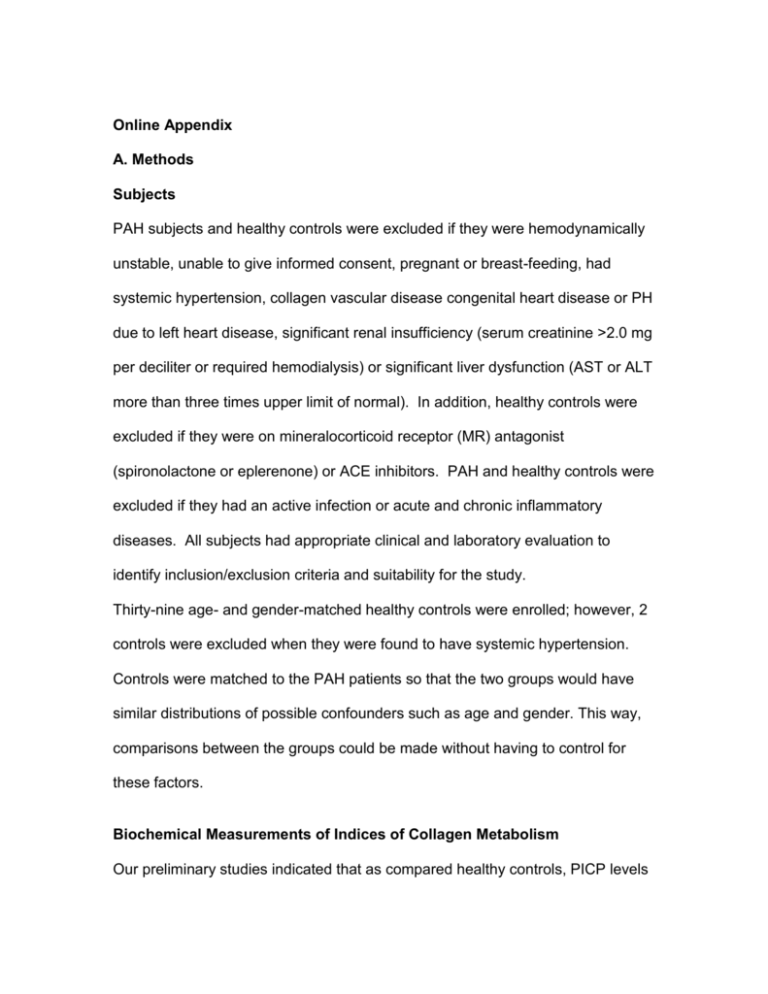
Online Appendix A. Methods Subjects PAH subjects and healthy controls were excluded if they were hemodynamically unstable, unable to give informed consent, pregnant or breast-feeding, had systemic hypertension, collagen vascular disease congenital heart disease or PH due to left heart disease, significant renal insufficiency (serum creatinine >2.0 mg per deciliter or required hemodialysis) or significant liver dysfunction (AST or ALT more than three times upper limit of normal). In addition, healthy controls were excluded if they were on mineralocorticoid receptor (MR) antagonist (spironolactone or eplerenone) or ACE inhibitors. PAH and healthy controls were excluded if they had an active infection or acute and chronic inflammatory diseases. All subjects had appropriate clinical and laboratory evaluation to identify inclusion/exclusion criteria and suitability for the study. Thirty-nine age- and gender-matched healthy controls were enrolled; however, 2 controls were excluded when they were found to have systemic hypertension. Controls were matched to the PAH patients so that the two groups would have similar distributions of possible confounders such as age and gender. This way, comparisons between the groups could be made without having to control for these factors. Biochemical Measurements of Indices of Collagen Metabolism Our preliminary studies indicated that as compared healthy controls, PICP levels were not elevated (N=22, p=0.828), whereas PIIINP (N=29, p=0.003) and CITP (N=28, p=0.004) levels were elevated in PAH patients. Therefore, we proceeded to measure and analyze these for the remainder of the study. MMP-9 levels were determined as it has a role in vascular remodeling, inflammatory responses and angiogenesis (7-10). The sensitivity (lower detection limit) of both the CITP and the PIIINP assays were approximately 0.3 ng/mL. Coefficients of variation (CV) derived from duplicate measurements were < 10% for both CITP and PIIINP assays. Serum MMP-9 and TIMP-1 levels were measured using 2-site sandwich ELISAs (R & D Systems, Inc., Minneapolis, MN) per manufacturer’s protocol. The MMP-9 assay (DMP900, sensitivity < 0.156 ng/mL) was designed to measure both the Pro - 92kDa and the active 82kDa form of MMP-9 in human serum. The TIMP-1 assay (DTM100, sensitivity was < 0.08 ng/mL) measures all forms of serum TIMP-1. CV from duplicate measurements were < 5% for both MMP-9 and TIMP-1 assays. Commercially available immunoassay was used for quantitative brain natriuretic peptide (BNP) determination on an ADVIA Centaur analyzer system according to the manufacturer’s recommendation. Sensitivity of the assay was <2.0 to 5000 pg/ml. Normal BNP value at our laboratory was ≤100 pg/ml. Doppler Echocardiography All parameters were measured in triplicates and averaged. The echocardiogram was undertaken with subject at rest, lying in the left lateral decubitus position. Ultrasound data was acquired using a Philips IE-33 scanner (Philips USA, Bothell, 1 WA USA) equipped with a X3-1 transducer. Images were analyzed off line using Digisonics software Version 3.8.1 (Digisonics, Houston, TX USA). Left ventricular ejection fraction was calculated using the Simpson's method of bi-plane discs (1). Left ventricular cardiac output and cardiac index were calculated using the pulse wave Doppler signal in the left ventricular outflow tract using the continuity equation (2). IVC size and variation with respiration were used to estimate the RAP as described by Lang et al (1). 2 B. Discussion We base our hypothesis on the findings from several studies that strongly support a role of extracellular matrix remodeling in the pathophysiology of PAH. For one, an in vitro study by Botney et al showed the presence of procollagen in the media and neointima of small muscular arteries and in plexiform lesions in severe idiopathic PAH subjects (3). More research has been done in which procollagen pro-peptide was detected in calves and rats exposed to hypoxia (4,5). Another study which implemented a high flow rat model of PAH demonstrated the presence of significantly increased expression of procollagen I and III mRNAs in the lungs of the shunted animals as compared to the control group (6). Moreover, a study in which animals that were exposed to hypoxia after being treated with recombinant adenovirus for the tissue inhibitor of metalloproteinases (TIMP) gene, thereby increasing TIMP expression in the lungs, showed that the animals developed higher pulmonary artery pressures, right ventricular hypertrophy, and an increased degree of muscularization and collagen deposition in their distal pulmonary arteries as compared to control animals (7). A similar finding to these was reported by Bishop et al, who found that collagen turnover rates were increased in the pulmonary arteries of rabbits with chemically induced pulmonary hypertension (8). Furthermore, immunohistochemical studies of fibrotic lungs have confirmed the presence of an increased proportion of type III collagen in early active fibrosis and an overabundance of rigid type I collagen in late fibrosis (9), which is consistent with our findings of increased PIIINP levels. Another investigation, which examined explanted lungs from PAH patients, 3 showed increased TIMP-1 expression and activity in pulmonary arteries and in the smooth muscle cells obtained from those lungs (10). Published research showed that in hypertensive heart failure patients with elevated cardiac filling pressures, an increase in circulating TIMP-1 levels relative to MMP1 levels suggested ongoing collagen synthesis (11). Several studies have shown that cardiac fibrosis histology measures are associated with circulating fibrosis biomarkers (12,13). These and other data established that excessive collagen metabolism due to progressive vascular remodeling plays a distinct role in the pathophysiology of PAH and that collagen content of a tissue may be assessed with the serum analysis of breakdown products of collagen. It is these findings that drive the hypothesis of our investigation. MMP-9 is present in low quantities in the healthy adult lung, but much more abundant in several lung diseases, including asthma, idiopathic pulmonary fibrosis, and chronic obstructive pulmonary disease. MMP-9 mediates endothelial cell invasion and its expression by fibrocytes may facilitate angiogenic processes (14). Despite numerous reports of MMP-9 in lung diseases such as asthma and IPF it is unclear whether MMP-9 has a causal role in lung remodeling or it is part of the inflammatory response. The relationship between the collagen biomarkers and/or the individual levels may be useful to determine the effects of vascular remodeling in PAH patients. As multiple biomarkers were investigated, we conducted Bonferroni adjustment for multiple hypotheses testing on the collagen biomarkers, echocardiogram parameters and walk test separately. The results did not change for biomarkers 4 and walk distance data. However, when we conducted the analysis for echocardiogram parameters, trend towards significance for S’ was not noted.” Limitations of the study. Higher levels of both PIIINP and CITP have been associated with left heart failure and LV dysfunction. However, in our data PIIINP showed a stronger association with disease severity in PAH. This could be due to the small sample size and to determine the adequacy of sample size, we have performed power calculations using the two-sample T test with unequal variances for comparing PIIINP and CITP between controls and PAHs. If the SD of the control is 1.21 (for CITP) and for the PAH is 2.38 (for CITP), we obtained a power of 80% when the sample size was 34 and 68 respectively. For PIIINP the power was even higher. Therefore, with a sample of 37 for the control, our study is sufficiently powered to detect a difference in both PIIINP and CITP levels between controls and PAH patients. 5 References 1. Lang RM, Bierig M, Devereux RB, et al. Recommendations for chamber quantification: a report from the American Society of Echocardiography's Guidelines and Standards Committee and the Chamber Quantification Writing Group, developed in conjunction with the European Association of Echocardiography, a branch of the European Society of Cardiology. J Am Soc Echocardiogr 2005;18:1440-63. 2. Quinones MA, Otto CM, Stoddard M, Waggoner A, Zoghbi WA. Recommendations for quantification of Doppler echocardiography: a report from the Doppler Quantification Task Force of the Nomenclature and Standards Committee of the American Society of Echocardiography. J Am Soc Echocardiogr 2002;15:167-84. 3. Botney MD, Liptay MJ, Kaiser LR, Cooper JD, Parks WC, Mecham RP. Active collagen synthesis by pulmonary arteries in human primary pulmonary hypertension. Am J Pathol 1993;143:121-9. 4. Crouch EC, Parks WC, Rosenbaum JL, et al. Regulation of collagen production by medial smooth muscle cells in hypoxic pulmonary hypertension. Am Rev Respir Dis 1989;140:1045-51. 5. Poiani GJ, Tozzi CA, Yohn SE, et al. Collagen and elastin metabolism in hypertensive pulmonary arteries of rats. Circ Res 1990;66:968-78. 6. Wei B, Du J, Li J, Qi J, Tang C. The modulating effect of L-arginine on collagen metabolism of pulmonary artery in pulmonary hypertension induced by a left-toright shunt. Zhonghua Yi Xue Za Zhi 2002;82:1273-5. 6 7. Vieillard-Baron A, Frisdal E, Eddahibi S, et al. Inhibition of matrix metalloproteinases by lung TIMP-1 gene transfer or doxycycline aggravates pulmonary hypertension in rats. Circ Res 2000;87:418-25. 8. Bishop JE, Guerreiro D, Laurent GJ. Changes in the composition and metabolism of arterial collagens during the development of pulmonary hypertension in rabbits. Am Rev Respir Dis 1990;141:450-5. 9. Low RB, Giancola MS, King TE, Jr., Chapitis J, Vacek P, Davis GS. Serum and bronchoalveolar lavage of N-terminal type III procollagen peptides in idiopathic pulmonary fibrosis. Am Rev Respir Dis 1992;146:701-6. 10. Lepetit H, Eddahibi S, Fadel E, et al. Smooth muscle cell matrix metalloproteinases in idiopathic pulmonary arterial hypertension. Eur Respir J 2005;25:834-42. 11. Gonzalez A, Lopez B, Querejeta R, Zubillaga E, Echeverria T, Diez J. Filling pressures and collagen metabolism in hypertensive patients with heart failure and normal ejection fraction. Hypertension;55:1418-24. 12. Izawa H, Murohara T, Nagata K, et al. Mineralocorticoid receptor antagonism ameliorates left ventricular diastolic dysfunction and myocardial fibrosis in mildly symptomatic patients with idiopathic dilated cardiomyopathy: a pilot study. Circulation 2005;112:2940-5. 13. Bruggink AH, van Oosterhout MF, de Jonge N, et al. Reverse remodeling of the myocardial extracellular matrix after prolonged left ventricular assist device support follows a biphasic pattern. J Heart Lung Transplant 2006;25:1091-8. 7 14. Hartlapp I, Abe R, Saeed RW, et al. Fibrocytes induce an angiogenic phenotype in cultured endothelial cells and promote angiogenesis in vivo. Faseb J 2001;15:2215-24. 8
